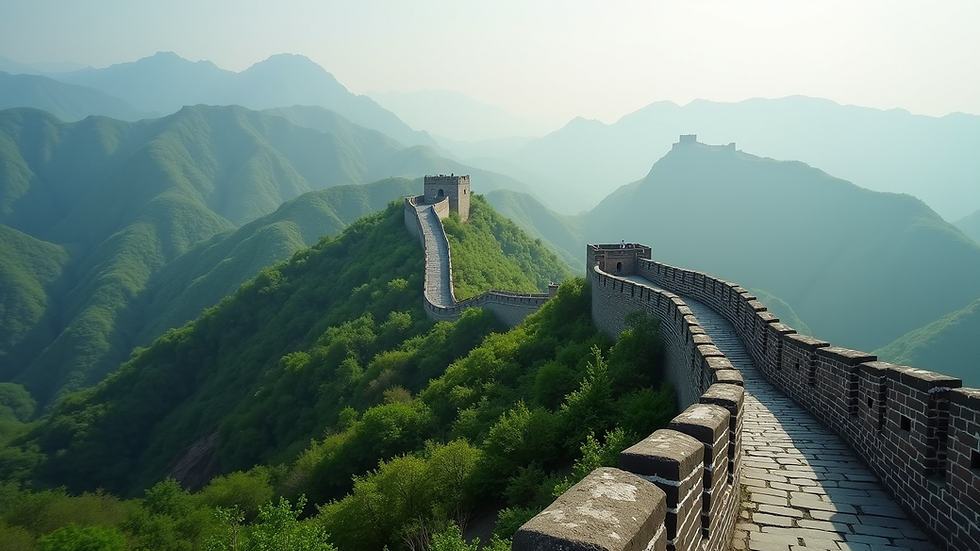Travel Blog | Graffiti Village &Qiongtai Valley Excursion
- OKDeal Travel
- May 11, 2021
- 3 min read
Article by: Jennifer Stamm
Okdeal Graffiti Village &Qiongtai Valley Trip in 1-3 October 2018
The Golden Week, in the People’s Republic of China, is a semi-annual national holiday implemented in 2000.
The holiday falls in the warm and vibrant colored month of October, making it a golden time for traveling around the country, hence the name “The Golden Week.”
Its a celebratory time in the most populous country, China, with a huge boom in the tourism industry. China attractions and landmarks are crawling with its residents relishing in the monumental sights of their country.

I decided to join “OKDealTravel,” for a group holiday excursion to China’s Eastern coastal province, Zhejiang.
First stop on the tour was to the humble village of Jinmankeng, in Tiantai County.
The village is recently acclaimed as the “Graffiti Village,” and is surprisingly known for its art culture!

The artistic village accomplished its ambition for ecotourism by hosting painting competitions; over 100 artists sped one month painting around 50,000 square meters of village homes.
The homes in this quaint countryside has attracted many visitors, benefiting its economic status. Visiting Jinmankeng, my surroundings were transformed with 3D murals that were painted on the villagers homes.


There was a massive roaring bear, “No face” from the film “Spirited Away,” a Chinese women in traditional manchu clothing, and transformative game obstacles from “Mario.”
I waited in a line of tourists wanting to snap a photo of themselves sitting on a window sill, which was illusioned as a swing hanging from the moon. Each home is painted drastically different from the next, as each was created by a different competitor.
The inconsistency in design is highly engaging; transfixing the mind into a different artist’s vision with every step.


On the second day of the trip we visited the Qiongtai Fairy Valley, in Tiantai County, to hike Tiantai Mountain.
Tiantai mountain is known as “Little Huangshan Mountain,” elevated at 3,734 feet! The scenic mountain houses the “Seven-Son Flower: Heptacodium miconiodes,” the exuberant flower population only thrives in nine places.
To climb the mountain there is a stepping stone trail upheld by Brobdingnagian granite walls and bridges, leading into the sky. Along the evergreen trail, waterfalls pour from the mountain into pools framed by overhead archways.



Tiantai means “platform of the sky,” but the term is designated to the School of Mahāyāna Buddhism, birthed in the Tiantai mountains. The Buddhist monk, Zhiyi, settled in the valley in 576, founded the Tiantai Buddhist sect.
When the Sui dynasty (581-618 AD) unified China in 589, Zhiyi, helped to give the sect to the new regime. The eminent monk’s dying wish of “wisdom,” was to build a temple, and seeing as Zhiyi was respected by ruler Sui, the Guoqing Temple was built in 598!

We’ve come to Day 3 of the trip: Guoqing Temple, based at the bottom of Tiantai mountain. This temple is unique in its historical richness, temple preservations, practicing Buddhists, and immense size.
Chinese pagodas such as the Sui Pagoda and the Seven Buddha Pagoda surround the temple.

Guoqing Temple has been restored many times post Sui Dynasty, and most recently, during the Qing Dynasty (1644-1911). It is one of China’s best preserved temples, consisting of 600 rooms and 14 halls.



The rustic burnt orange colored temple, smells of burning incense and hosts Buddhists dressed in long robes, walking the architected phenomenon.
Observing worshipers bowing to colossal statues of Buddhist deities surrounded by ancient walls, was an enlightening experience.


For three days and two nights the trip cost 1250 RMB per person including:
shuttle bus transportation from and to Shanghai, two-night accommodation in a local guest house in Hou’an village, all meals, tour excursion entrance fee, alcohol/snacks for evening social events (campfire and karaoke provided), tour guides and trip insurance.
The breakfast provided was an assortment of western and Chinese essentials like: bread, coffee, Nutella, egg with tomato and steamed buns.
Lunch and dinner was a tasty spread of traditional Chinese dishes like sautéed eggplant, kung pao chicken, ma po tofu and vegetable rice noodles.
During meals tour group members sat Chinese style nestling a round table, which they would slowly spin, sampling each of about 15 different dishes. Two social parties were hosted where we met other travel group members over roasted marshmallows around a campfire.


The provided guest house was very comfortable and peaceful. Every morning I woke in the fresh air of the countryside with a day of either mountain hiking, visiting green pools, waterfalls, or temples ahead.


The tour was well organized and all excursions were chauffeured and timely. I will definitely go on another trip with “OKDeal Travel!”



















Comments